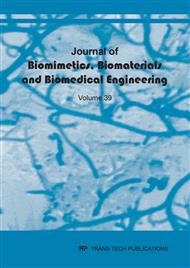[1]
Zhang, S., Li, L. 2013. The differential effects of foot sole sensory on plantar pressure distribution between balance and gait. Gait & posture, 37, 532-535.
DOI: 10.1016/j.gaitpost.2012.09.012
Google Scholar
[2]
Sobhani, S., Hijmans, J., Van, d.H.E., Zwerver, J., Dekker, R., Postema, K., 2013. Biomechanics of slow running and walking with a rocker shoe. Gait & Posture, 38(4), 998-1004.
DOI: 10.1016/j.gaitpost.2013.05.008
Google Scholar
[3]
Andreia, S.P. Sousa, Rui, M., Rubim, S., Filipa, S., Andreia, S., João Manuel R. S. Tavares., 2016. Influence of prolonged wearing of unstable shoes on upright standing postural control. Human Movement Science, 45, 142-153.
DOI: 10.1016/j.humov.2015.11.015
Google Scholar
[4]
Lin, S.Y., Su, P.F., Chung, C.H., Hsia, C.C., Chang, C.H. 2017. Stiffness effects in rocker-soled shoes: biomechanical implications. Plos One, 12(1), e0169151.
DOI: 10.1371/journal.pone.0169151
Google Scholar
[5]
Lohrer, H., Turbanski, S., Nauck, T., Schmidtbleicher, D., 2008. Balance therapy shoes - a comparative analysis with respect to immediate training effects. Sportverletzung Sportschaden, 22(4), 191-195.
Google Scholar
[6]
Turbanski, S., Lohrer, H., Nauck, T., Schmidtbleicher, D., 2011. Training effects of two different unstable shoe constructions on postural control instatic and dynamic testing situations. Physical Therapy in Sport Official Journal of the Association of Chartered Physiotherapists in Sports Medicine, 12(2), 80-86.
DOI: 10.1016/j.ptsp.2011.01.001
Google Scholar
[7]
Boyer, K.A., Federolf, P., Lin, C., Nigg, B. M., Andriacchi, T. P., 2012. Kinematic adaptations to a variable stiffness shoe: Mechanisms for reducing joint loading. Journal of Biomechanics, 45, 1619-1624.
DOI: 10.1016/j.jbiomech.2012.04.010
Google Scholar
[8]
Janisse, D. J., Janisse, E., 2008. Shoe modification and the use of orthoses in the treatment of foot and ankle pathology. Journal of the American Academy of Orthopaedic Surgeons, 16(3), 152-158.
DOI: 10.5435/00124635-200803000-00006
Google Scholar
[9]
Park, S.B., Lee, T.Y., Lee, K.D., Kim, D.W., Yoo, J.H., Kim, K.H., 2013. Kinetics and kinematics effects of variable stiffness shoe on lower extremity. Footwear Science, 5(sup1), S62-S64.
DOI: 10.1080/19424280.2013.799558
Google Scholar
[10]
Anderson, J.R., Nester, C.J., Williams, A.E., 2017. The effect of prolonged standing on the body and the impact of footwear hardness. Footwear Science, 9, S67-S68.
DOI: 10.1080/19424280.2017.1314342
Google Scholar
[11]
Nigg, B.M., Stefanyshyn, D., Cole, G., Stergiou, P., Miller, J., 2003. The effect of material characteristics of shoe soles on muscle activation and energy aspects during running. Journal of Biomechanics, 36(4), 569-575.
DOI: 10.1016/s0021-9290(02)00428-1
Google Scholar
[12]
Stacoff, A., Reinschmidt, C., Nigg, B.M., Aj, V.D.B., Lundberg, A., Denoth, J., 2001. Effects of shoe sole construction on skeletal motion during running. Medicine & Science in Sports & Exercise, 33(2), 311.
DOI: 10.1097/00005768-200102000-00022
Google Scholar
[13]
Stöggl, T., Haudum, A., Birklbauer, J., Murrer, M., Müller, E., 2010. Short and long term adaptation of variability during walking using unstable (mbt) shoes. Clinical Biomechanics, 25(8), 816-822.
DOI: 10.1016/j.clinbiomech.2010.05.012
Google Scholar
[14]
Yan, Z., Yaodong, G., Gusztáv, F., 2017. Review on biomechanical and epidemiological research on injuries from high heels. Journal of Ningbo University (Natural Science & Engineering Edition), 381-89.
Google Scholar
[15]
Yaodong, G., Yong, L., Qichang, M., Jianshe, L., James, R., 2014. Effects of different unstable sole construction on kinematics and muscle activity of lower limb. Human movement science, 36, 46-57.
DOI: 10.1016/j.humov.2014.04.008
Google Scholar
[16]
Waddington, G.S., Adams, R.D., 2004. The effect of a 5-week wobble-board exercise intervention on ability to discriminate different degrees of ankle inversion, barefoot and wearing shoes: a study in healthy elderly. Journal of the American Geriatrics Society, 52(4), 573–576.
DOI: 10.1111/j.1532-5415.2004.52164.x
Google Scholar
[17]
Valderrabano, V., Hintermann, B., Nigg, B.M., Stefanyshyn, D., Stergiou, P., 2003. Kinematic changes after fusion and total replacement of the ankle: part 2: movement transfer. Foot & ankle international / American Orthopaedic Foot and Ankle Society [and] Swiss Foot and Ankle Society, 24(12), 897.
DOI: 10.1177/107110070302401204
Google Scholar
[18]
Milner, C.E., Ferber, R., Pollard, C.D., Hamill, J., Davis, I.S., 2006. Biomechanical factors associated with tibial stress fracture in female runners. Medicine & Science in Sports & Exercise, 38(2), 323.
DOI: 10.1249/01.mss.0000183477.75808.92
Google Scholar
[19]
Pohl, M.B., Hamill, J., Davis, I. S., 2009. Biomechanical and anatomic factors associated with a history of plantar fasciitis in female runners. Clinical Journal of Sport Medicine Official Journal of the Canadian Academy of Sport Medicine, 19(5), 372-376.
DOI: 10.1097/jsm.0b013e3181b8c270
Google Scholar
[20]
Bahlsen, A., 1989. The etiology of running injuries: A longitudinal, prospective study. Unpublished doctoral dissertation, University of Calgary, Calgary, AB, Canada.
Google Scholar
[21]
Nurse, M.A., Nigg, B.M., 2001. The effect of changes in foot sensation on plantar pressure and muscle activity. Clinical Biomechanics, 16(9), 719-727.
DOI: 10.1016/s0268-0033(01)00090-0
Google Scholar
[22]
Carl, H.D., Pfander, D., Swoboda, B., 2006. Assessment of plantar pressure in forefoot relief shoes of different designs. Foot & Ankle International, 27(2), 117-120.
DOI: 10.1177/107110070602700208
Google Scholar
[23]
Fuller, E., Schroeder, S., Edwards, J., 2001. Reduction of peak pressure on the forefoot with a rigid rocker-bottom postoperative shoe. Journal of the American Podiatric Medical Association, 91(10), 501-507.
DOI: 10.7547/87507315-91-10-501
Google Scholar
[24]
Song, Y.W., Cai, Y. X., Kou, H.J., Hua, Y.F., 2009. Footwear sole hardnesses and plantar pressure during human walking. Journal of Clinical Rehabilitative Tissue Engineering Research, 13, 9113-9116.
Google Scholar
[25]
Fengling, L., Qichang, M., Yaodong, G., 2015. Effects of unstable elements with different hardness on lower limb loading. Acta of Bioengineering & Biomechanics, 17(2), 85.
Google Scholar
[26]
Zhang, B., Li, S., & Zhang, Y. 2017. Evaluation of Dynamic Posture Control when Wearing High-Heeled Shoes Using Star Excursion Balance Test. Physical Activity and Health,1(1),1–7.
DOI: 10.5334/paah.1
Google Scholar


